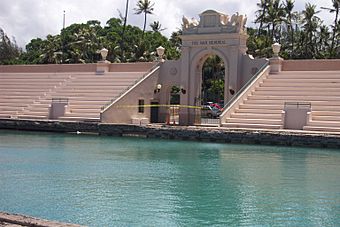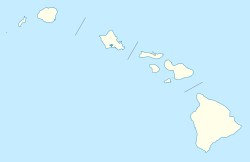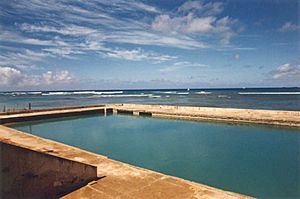Waikiki Natatorium War Memorial facts for kids
Quick facts for kids |
|
|
War Memorial Natatorium
|
|

The inside of the Natatorium, looking at the bleachers
|
|
| Location | Kalakaua Avenue, Honolulu, Hawaii |
|---|---|
| Area | 5.3 acres (2.1 ha) |
| Built | 1927 |
| Architect | Lewis P. Hobart |
| Architectural style | Beaux Arts |
| NRHP reference No. | 80001283 |
| Added to NRHP | August 11, 1980 |
The Waikiki Natatorium War Memorial is a special place in Honolulu, Hawaii, USA. It's a memorial built like a large swimming pool that uses ocean water. This unique memorial honors the brave men and women from Hawaii who served in World War I, which was a very big war.
Contents
How the Memorial Was Created
Early Ideas for a War Memorial
In March 1918, a group called the Daughters and Sons of Hawaiian Warriors had an idea. They wanted to create a memorial for the more than 10,000 people from Hawaii who volunteered in World War I. The Honolulu Ad Club liked this idea.
On November 20, 1918, they formed a committee to explore the concept. Colonel Howard Hathaway, Ned Loomis, and W.D. Westervelt led this group. They invited representatives from many community groups to a meeting on December 6, 1918. At this meeting, Colonel Hathaway became the chairman, and Fred W. Beckley became the secretary of the main committee.
Choosing a Design and Location
At their next meeting, a smaller group was formed. This group was tasked with looking into designs and estimating costs for the memorial. Important members of this subcommittee included Princess Kalanianaole and Senator John H. Wise.
This subcommittee suggested buying the old William G. Irwin Estate. This land was located between the shoreline and Kapiolani Park in Waikiki. Everyone agreed this would be a great spot for a public park and the memorial. To make this happen, John Guild, Mrs. Walter Macfarlane, and others worked hard to get the property.
A bill, or proposed law, was passed easily by the local government. The governor signed it on April 29, 1919. This law allowed the state to buy the Irwin property using special bonds. It also said the land should be called "Memorial Park."
The Memorial Park was officially dedicated on November 11, 1919. This date was exactly one year after the end of World War I. The American Legion, a group of veterans, organized the dedication event.
Deciding on the Natatorium
In 1920, with the land secured, a new committee was formed. Their job was to recommend designs for the memorial itself. This committee included many people, such as J.K. Butler, Senator L.M. Judd, and Milo Vanek.
After a lot of discussion, the committee made its final recommendation. They decided on a "memorial natatorium." A natatorium is a building with a swimming pool. This one would have a pavilion and beautiful landscaping in Memorial Park. The swimming pool itself would be very large, like those used in the Olympics.
On the first day of the 1921 Territorial Legislature, Senator L.M. Judd introduced a new bill. This bill was for building the war memorial at Memorial Park. It would be paid for by issuing more bonds. The bill stated that the memorial would honor "the men and women of Hawaii who served during the great war." This was an important change, as it now included all who served, not just those who died.
Both parts of the legislature passed the bill. The governor signed it on March 15, 1921, making it Act 15.
Act 15 set three main rules for the memorial's design:
- It had to be at Memorial Park in Waikiki.
- It must have a swimming course at least 100 meters long.
- All other design details would be chosen through a design contest. A special Territorial War Commission, appointed by the Governor, would oversee this.
Building the Memorial
The Design Contest
Act 15 also created the Territorial War Memorial Commission. This group would decide on the memorial's features beyond the required 100-meter pool and location. Governor Charles J. McCarthy appointed the members: A. Lester Marks (Chairman), John R. Galt (Secretary), and A.L.C. Atkinson (later replaced by J.K. Butler).
Louis Christian Mullgardt, a famous architect, was hired to help. He prepared a general plan for the park. He also organized a design competition, following the rules of the American Institute of Architects.
A special jury judged the designs. This jury included the Governor of Hawaii, the Mayor of Honolulu, and well-known architects Bernard R. Maybeck, Ellis F. Lawrence, and W. R. B. Willcox.
The jury chose the design by San Francisco architect Lewis P. Hobart as the winner. They praised his design for its "fine, discriminating taste" and how it captured the "color and flavor of Hawaii and Honolulu." They believed it would be a memorial that would be admired for a very long time.
The Natatorium Today
The Waikiki Natatorium War Memorial was finished in 1927. It is located in Honolulu, west of Kapiʻolani Park. The building is designed in the Hawaiian Beaux-Arts style. This style often includes grand entrances. The memorial's entrance has a large arch with four stone eagles, which is typical of this design.
Inside, there is a huge saltwater swimming pool. It is 100 meters long and 40 meters wide. On opening day, August 24, 1927, Hawaii's own Olympic gold medalist, Duke Kahanamoku, took the first swim. It was also his birthday!
In a swim meet held soon after, world record holder Johnny Weissmuller (who later played Tarzan in movies) won several races. Another local swimmer, Buster Crabbe, also won a long-distance race.
Later Years and Current State
After the attack on Pearl Harbor in 1941, the U.S. Army took over the natatorium. They used it for training during World War II. In 1949, it was fixed up and given to the City and County of Honolulu.
Over time, the natatorium started to fall apart. It was officially closed in 1963, but people still used it. On August 11, 1980, it was added to the National Register of Historic Places listings in Oahu. This means it is recognized as an important historical site.
There have been many discussions about what to do with the natatorium. Some people want to tear it down, while others believe it should be saved and repaired. For many years, it was a popular spot for locals and tourists. However, it closed to the public in 1979 because of safety worries. City leaders have gone back and forth on whether to fix it or demolish it.
Plans for the Future
In 2018-2019, the City and County of Honolulu started a study. They wanted to see if the memorial could be reopened. The study looked at different ways to fix the memorial. The goal is to make it safe and usable again. This would allow it to properly honor WW1 veterans.
The study noted that if nothing is done, the run-down building will have a "significant and adverse" impact on the community. The city mayor thinks it would cost about $25.6 million to renovate it. Singer Bruno Mars has even started a fundraising campaign to help, which has raised some money so far.
Kaimana Beach
Right next to the Natatorium is Kaimana Beach. This is a very popular beach for people living in Kaimuki, Manoa, Diamond Head, and other nearby areas of Honolulu. Kaimana is a sandy beach with palm trees. It has a lifeguard tower, showers, and public parking.
Kaimana Beach used to be mostly rocky with only a small strip of sand. It was also known as Sans Souci Beach, which means "without worries" in French. This name came from a hotel run by George Lycurgus in 1893, which was named after the Sanssouci Palace in Germany.
After the Waikiki War Memorial Natatorium was built, the beach became much wider and sandier. This is why it is so popular today. The name Kaimana is not an old Hawaiian name. It's actually the Hawaiian way of saying "Diamond Head," which is the famous landmark nearby. The old Sans Souci hotel site is now the New Otani Kaimana Beach Hotel.
Kaimana Beach was also the end point for the first submarine communications cable between California and Hawaii. In 1902, Duke Kahanamoku's uncle, David Piikoi, is said to have pulled the underwater cable onto Kaimana's shore. The first telegraph message sent over this new cable was on January 1, 1903. It went from Henry Ernest Cooper to President Theodore Roosevelt in Washington, DC.
Images for kids





